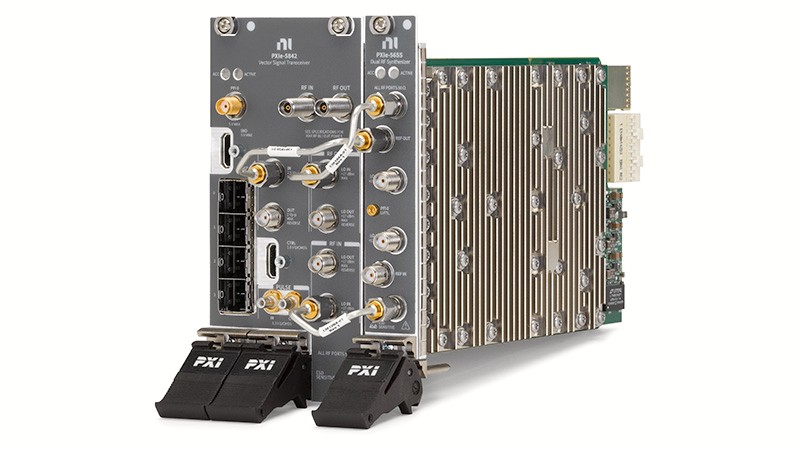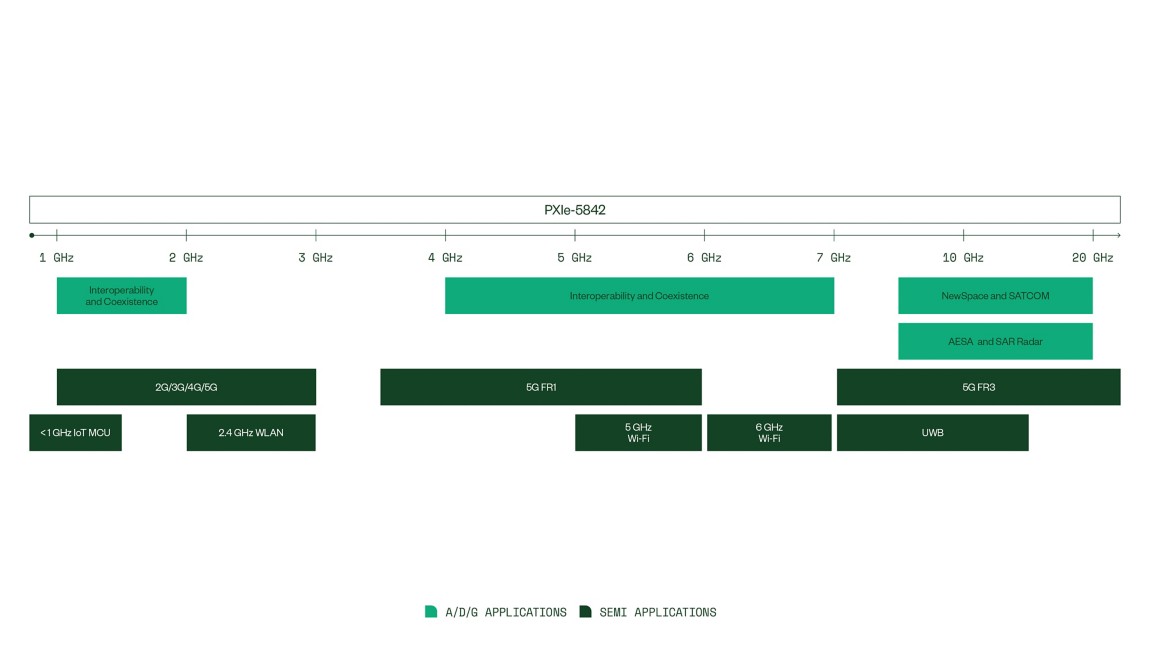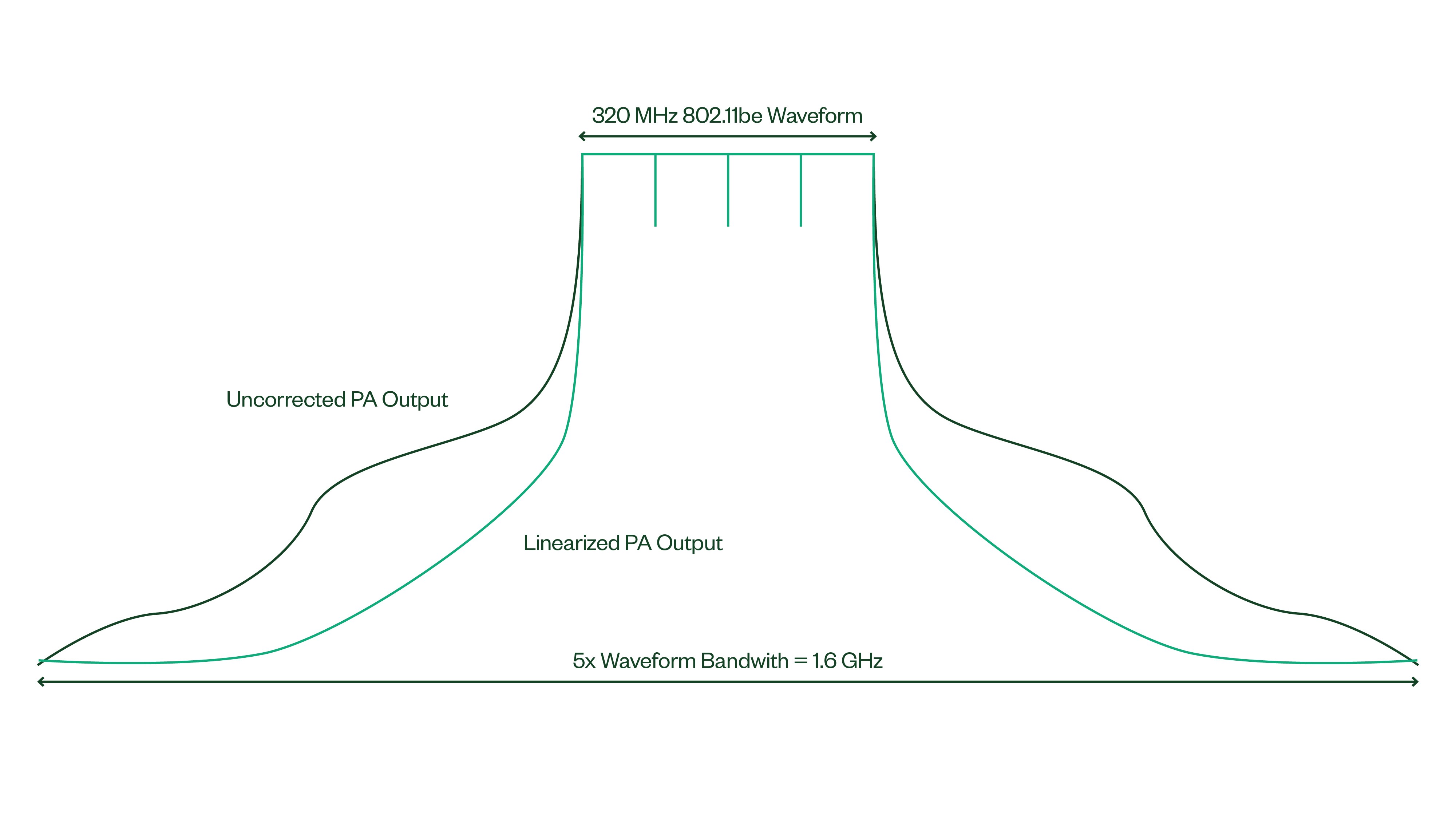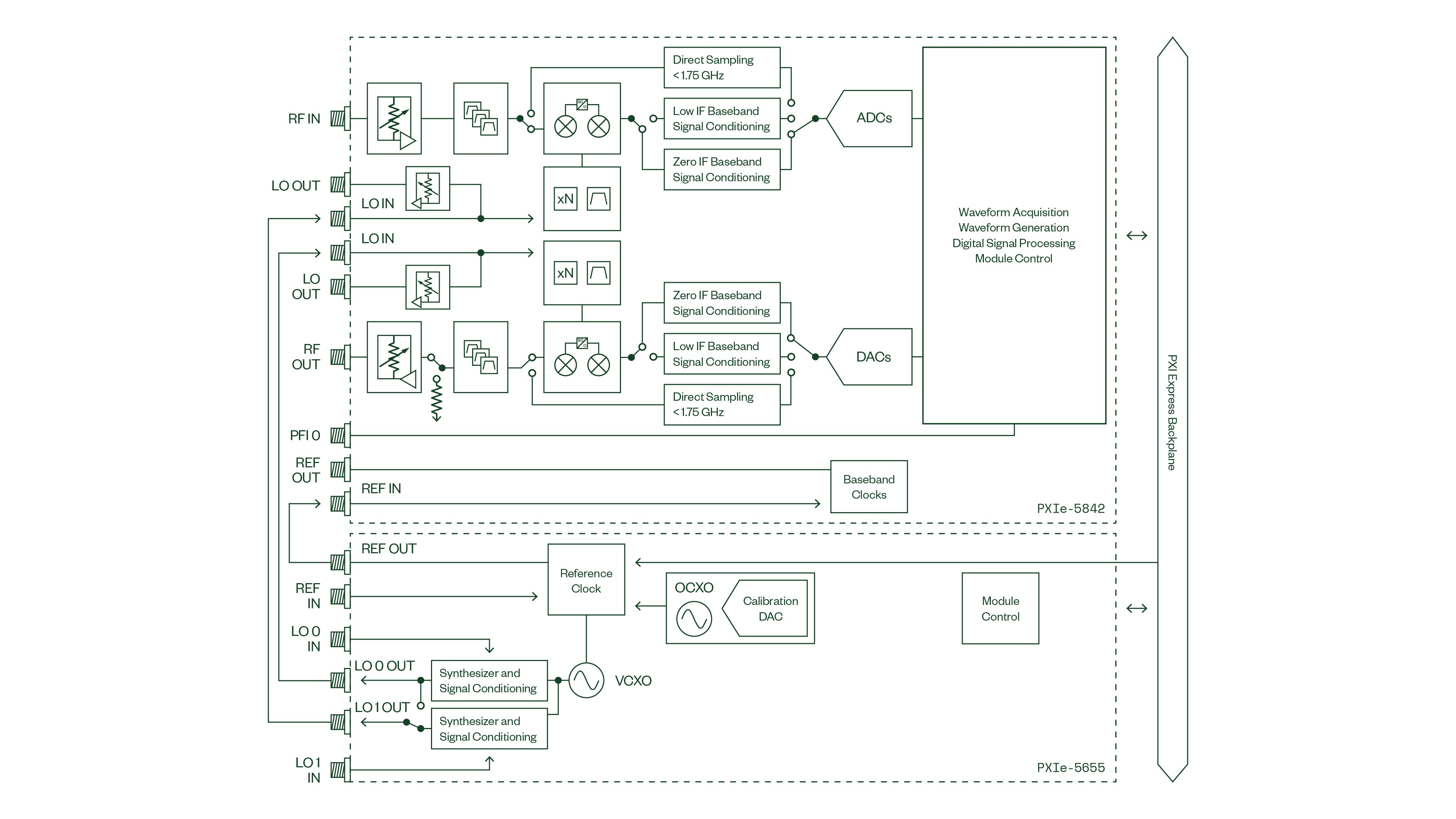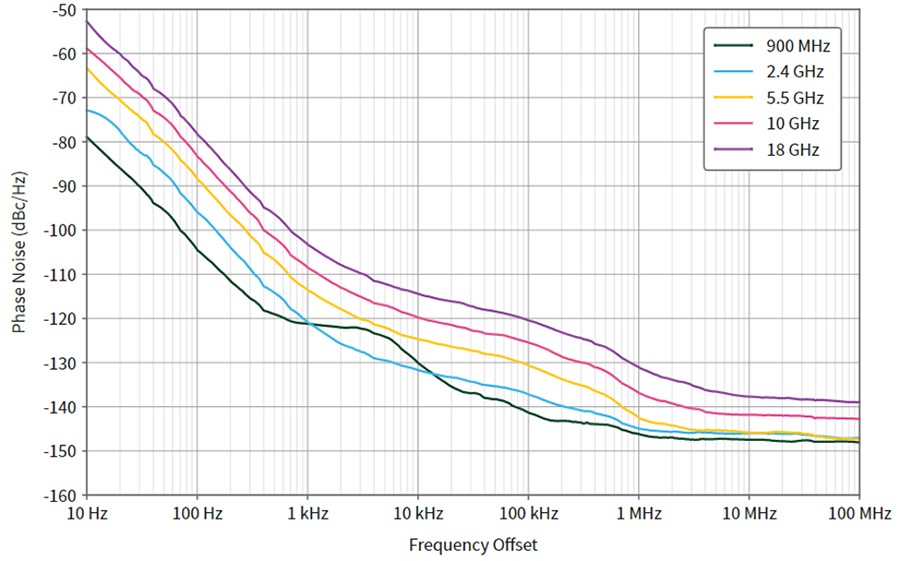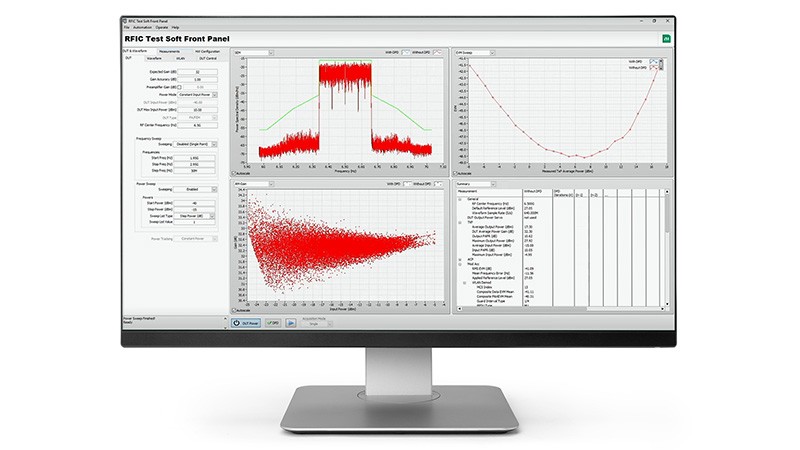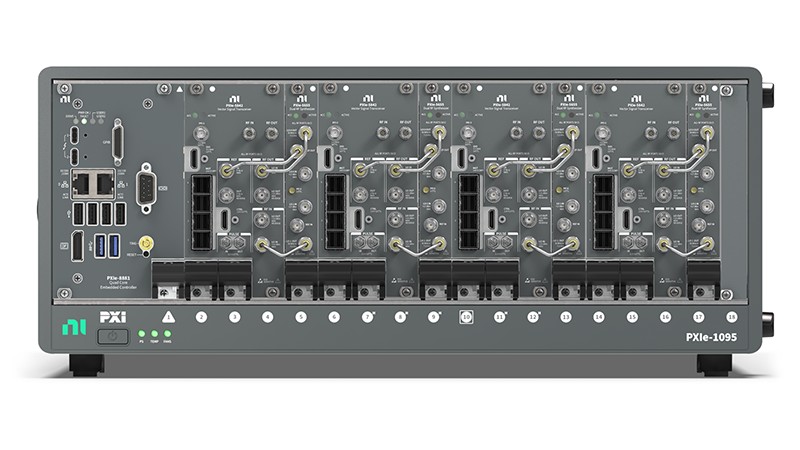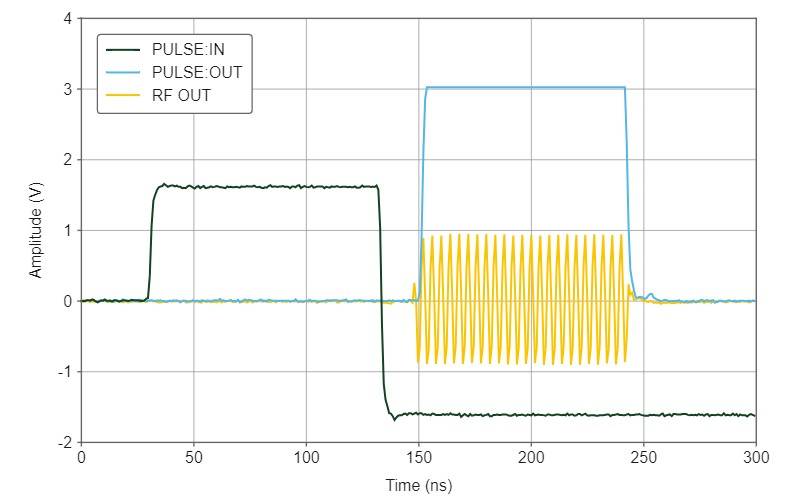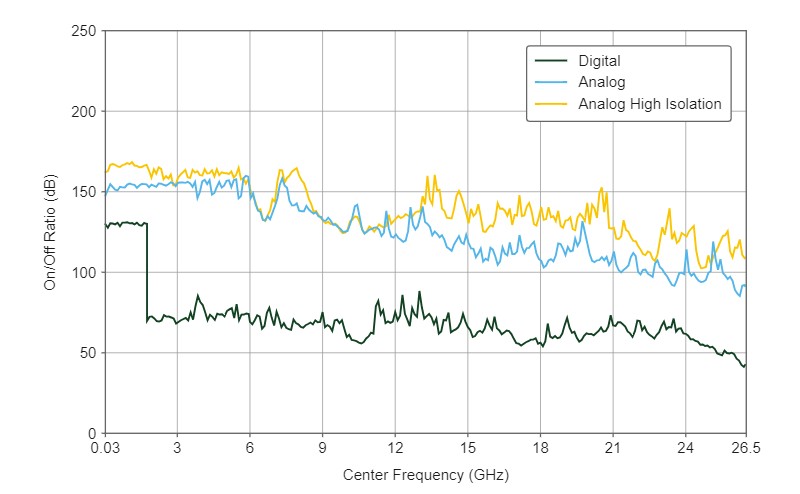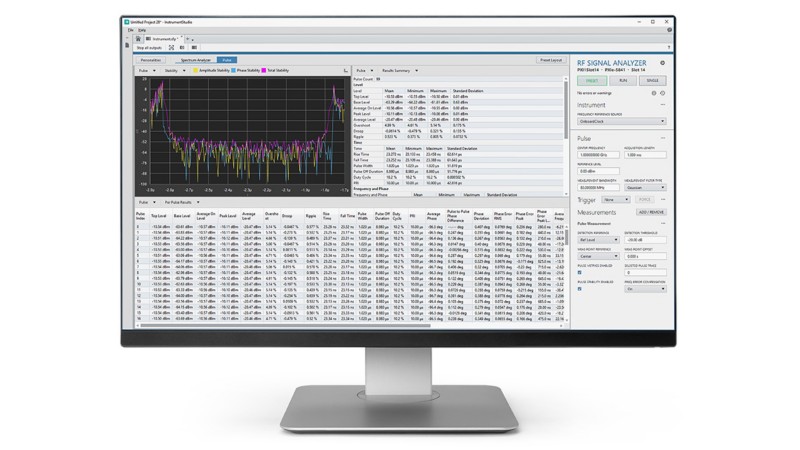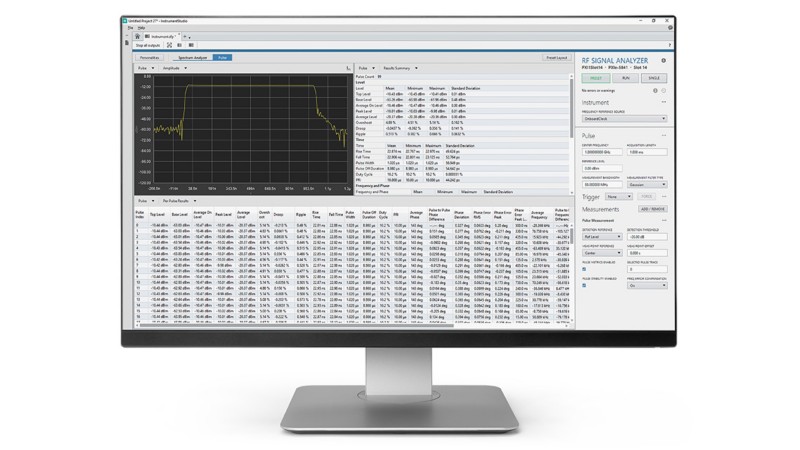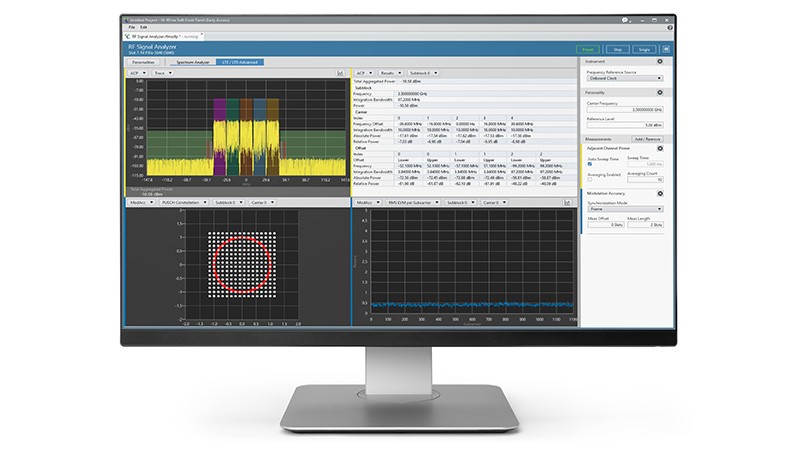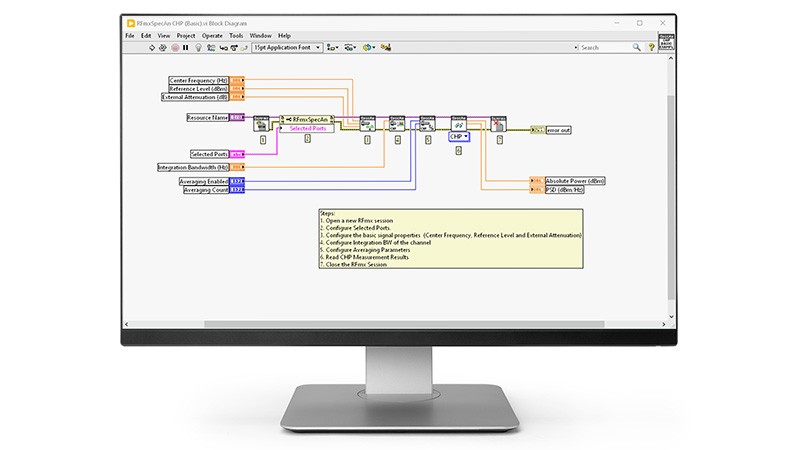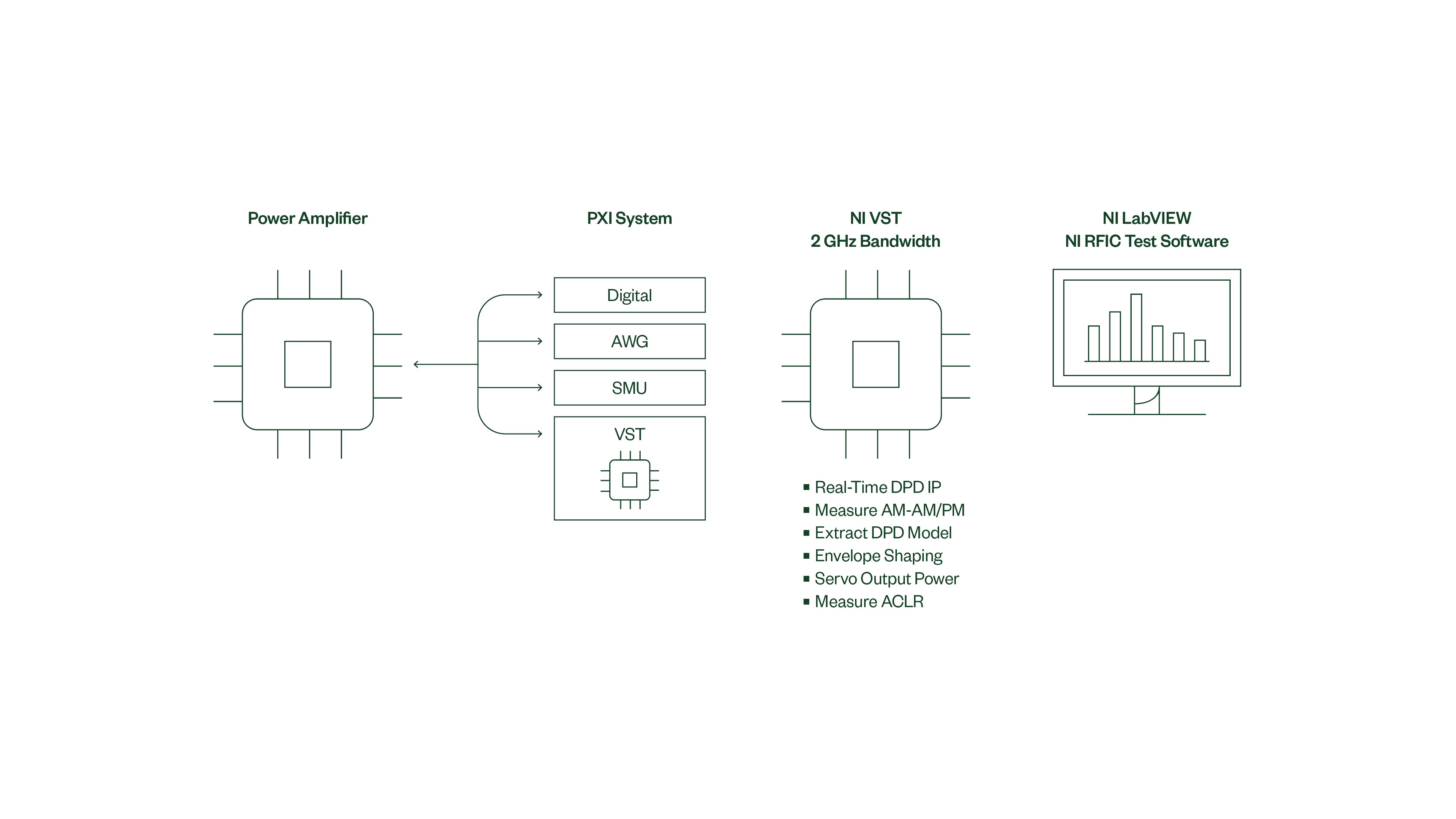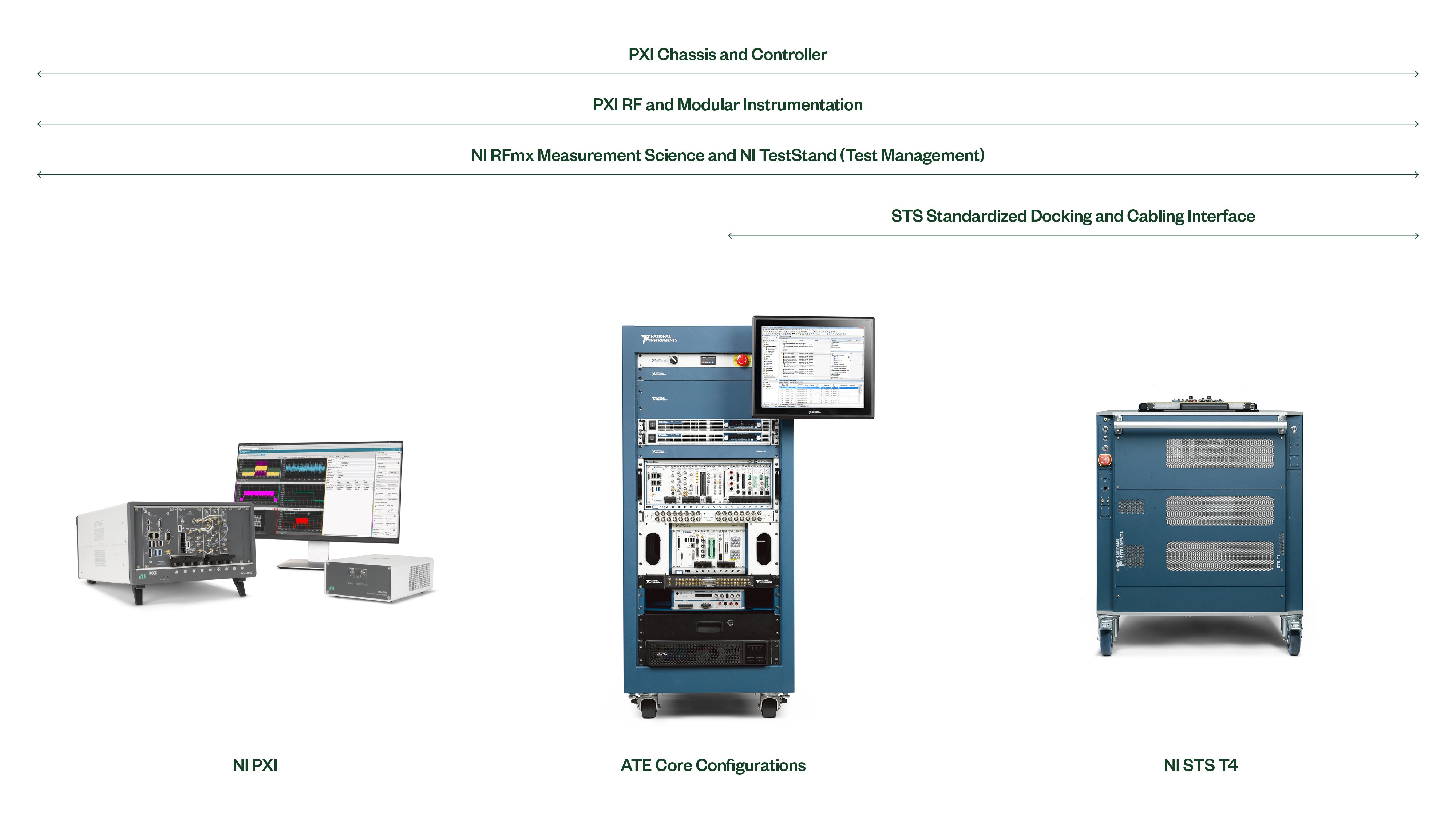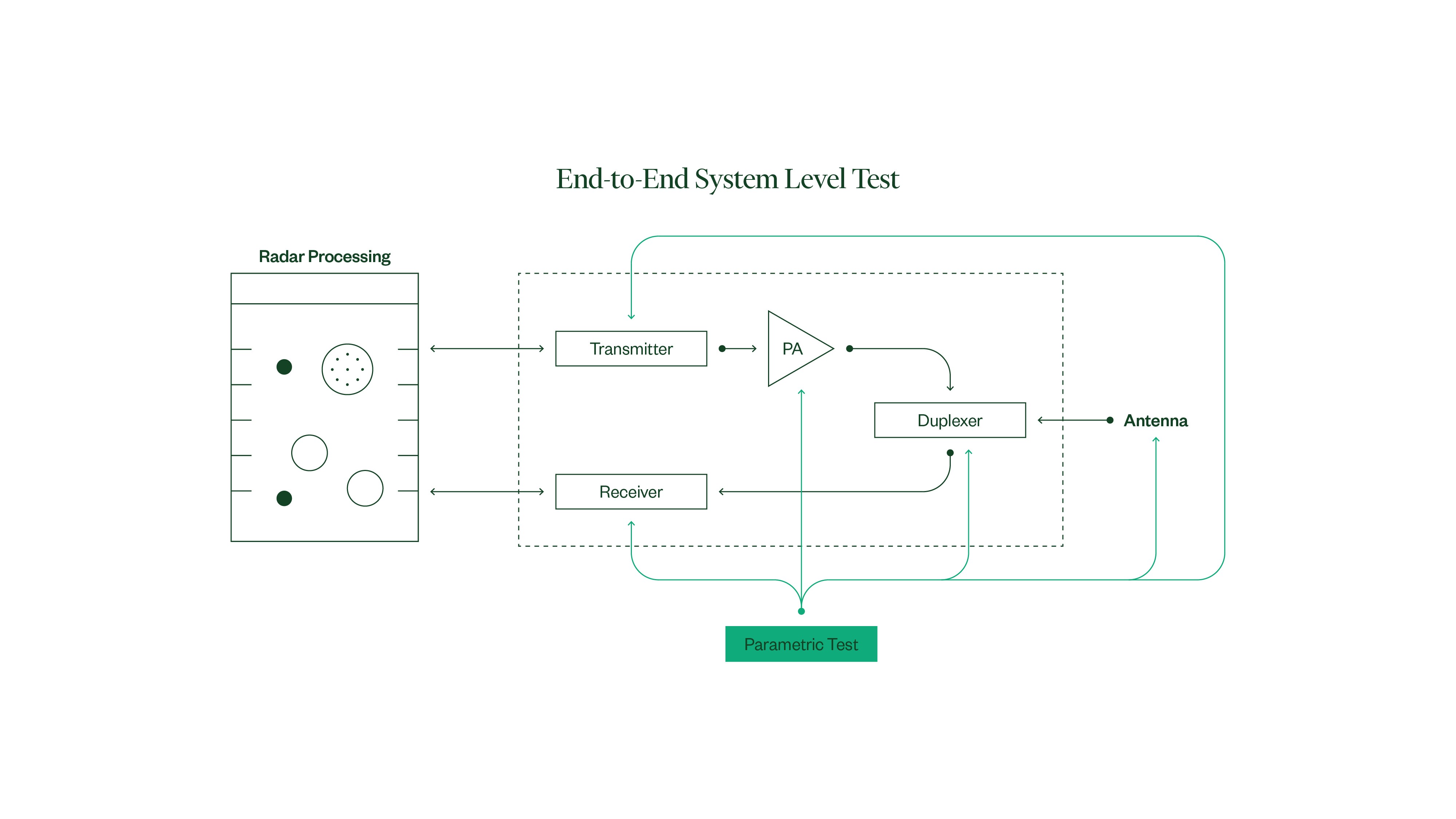Introduction to the PXIe-5842 Third-Generation PXI Vector Signal Transceiver
Contents
- Introduction
- Key PXIe-5842 VST Features
- PXI VST Software Tools
- PXI VST Applications
- Conclusion
- Next Steps
Introduction
NI introduced the concept of a vector signal transceiver (VST) in 2012. A VST combines an RF signal generator, an RF signal analyzer, and a powerful FPGA onto a single PXI module. The PXIe-5842 VST is the first VST to offer a continuous frequency coverage from 30 MHz all the way up to 26.5 GHz. It doubles the available instantaneous bandwidth from previous models to 2 GHz and provides overall RF performance improvements on key metrics like error vector magnitude (EVM) or average noise density.
| Specification | PXIe-5842 Performance |
|---|---|
| Frequency Range | 30 MHz to 26.5 GHz |
| Bandwidth | Up to 2 GHz |
| Tx/Rx Amp. Accuracy | ± 0.4 dB typ. |
| Tx/Rx Flatness | ± 0.45 dB typ. (2 GHz BW) |
| EVM (5G NR) | -58 dB (100 MHz, loopback, measured, noise compensation enabled) |
| EVM (802.11be) | -52 dB (320 MHz, loopback, measured, noise compensation enabled) |
| Maximum Output Power | +25 dBm typ. (CW @ 5 GHz) |
| Tuning Time | <230 µs |
| PXI Express Slots | 4 |
Table 1: PXIe-5842 Specifications. Refer to the specifications document for more information.
Figure 1: The PXIe-5842 Third-Generation PXI Vector Signal Transceiver
As a result, VSTs serve a wide range of RF design and test applications and are ideally suited for applications that require an RF stimulus and RF response. Example applications include Wi-Fi 7 and 5G wireless design validation and production test, prototyping, and channel sounding for sub-THz (6G) research, RFIC validation and characterization for PAs and transceivers for Electronically Scanned Arrays (ESA) and wireless communications, ESA characterization utilizing digital transmit/receive modules (DTRM), radar system validation, and communications and signal intelligence validation test.
Key PXIe-5842 VST Features
The PXIe-5842 features a high-performance RF signal generator and RF signal analyzer. Both instruments use direct conversion from I/Q to RF and are optimized for excellent measurement quality.
Key technical features:
- Wide frequency range
- Wide instantaneous bandwidth
- Optimized RF front end
- High-Performance Local Oscillator (LO)
- Modular architecture
- RF pulsing capabilities
- Digital Interface for Data Streaming
Wide Frequency Range
The PXIe-5842 is the first VST to offer continuous frequency coverage from 30 MHz to 26.5 GHz in one instrument. Applications and standards ranging from WLAN, ultra-wideband (UWB), Bluetooth, 5G NR, and radio prototyping can now all be tested with one capable and versatile instrument. The combination of the cutting-edge dual synthesizer (PXIe-5655) with the high-frequency coverage means that you can use the PXIe-5842 for various aerospace and defense applications (A/D/G) from the VHF to K bands, like radar target simulation, spectrum monitoring in electronic warfare and satellite communications, or for parametric test of electronically scanned arrays (ESAs) components commonly used in radar and satellite communication systems.
Figure 2: Commercial Applications Spanning the RF Spectrum and SATCOM Proliferation
Wide Instantaneous Bandwidth
Wireless standards today like Wi-Fi or 5G NR use significantly wider bandwidth channels to achieve higher peak data rates. The latest 802.11be Wi-Fi standard defines a maximum channel bandwidth of 320 MHz. The 5G NR standard defines a maximum channel bandwidth of 400 MHz in the FR1. These standards will continue to evolve with more channel bandwidth support over the years to come.
In addition, the bandwidth requirements of the instrument often exceed the bandwidth of the wireless communications channel. For example, when testing RF power amplifiers (PAs) under digital predistortion (DPD) conditions, the test equipment itself must extract a PA model, correct for nonlinear behavior, and then generate a corrected waveform. Advanced DPD algorithms often require three to five times the RF signal bandwidth. As a result, instrument bandwidth requirements can be up to 2 GHz for 5G NR FR1 (400 MHz signal) and 1.6 GHz for 802.11be (320 MHz signal).
Figure 3: DPD Algorithm Using 5X Signal Bandwidth
A significant enhancement of the PXIe-5842 VST is its wider instantaneous bandwidth of 2 GHz. This wider bandwidth means that engineers can solve more challenging applications. For example, in tests for 5G NR devices, many of the 5G carriers are separated by several hundred megahertz. With the wide bandwidth of the PXIe-5842, engineers can use a single instrument to generate or analyze multiple 5G NR carriers instead of using multiple instruments.
In addition, wideband radar systems often require up to 2 GHz of signal bandwidth to accurately capture pulsed signals. Also, in spectrum monitoring systems, the bandwidth of the instrument can dramatically improve the scan rate. Finally, wide signal bandwidth is an essential requirement for many advanced research applications.
| Increasing Channel Bandwidth | ||||||
|---|---|---|---|---|---|---|
| Cellular | Wi-Fi | A/D/G | ||||
| LTE-Advanced | 100 MHz | Wi-Fi 6 | 80 MHz | SATCOM | ||
| 5G NR FR1 | 400 MHz | Wi-Fi 6 | 160 MHz | Radar | ||
| 5G NR FR2 | 2000 MHz | Wi-Fi 7 | 320 MHz | EW | ||
| 3x Bandwidth for Adjacent Channel Power | 5x Bandwidth for Digital Predistortion | ||||||
Table 2: Evolution of Channel Bandwidth for Wireless Standards
Optimized RF Front End
The PXIe-5842 design has three distinct receiver/transmitter baseband paths that optimize the RF front end for best performance under each test condition:
- Direct RF sampling path for center frequencies below 1.75 GHz. This path allows for a simpler RF chain, resulting in generation and acquisition without impairments like LO leakage and residual sideband image.
- Low IF baseband path optimized for high dynamic range for signals with instantaneous bandwidth (IBW) up to 900 MHz. On this path, the signal generator and the signal analyzer offset the LO to a frequency out of band allowing for improved frequency response and better average noise density by 3 dBm/Hz.
- Zero IF baseband path, which is optimized for wide bandwidth signals with an IBW up to 2 GHz.
Figure 4: PXIe-5842 Vector Signal Transceiver (VST) Simplified Block Diagram
High-Performance LO
The PXIe-5842 VST is comprised of the PXIe-5842 module and the high-performance dual LO synthesizer, the PXIe-5655, which has an excellent phase noise performance.
Figure 5: PXIe-5842 VST Measured RF Input Phase Noise
The next-generation wireless devices have even more stringent EVM performance requirements. With higher order modulation schemes and wideband multicarrier signal configurations, the RF front ends of today’s wireless devices require better linearity and phase noise to deliver the required modulation performance. Consequently, test instrumentation for wireless device test must deliver even more accurate RF performance. The PXIe-5842 VST uses advanced, patented I/Q calibration techniques to deliver best-in-class EVM performance for wideband signals. For example, for an 802.11be, 320 MHz, 4096-QAM, 12 dB PAPR waveform, the PXIe-5842 achieves -52 dB EVM. This performance can be further improved using NI’s patented cross-correlation technique, available through our RFIC Test Software.
Figure 6: 802.11be Device Under Test with PXIe-5842 and RFIC Test Software
Good phase noise is one of the most critical factors in a modern radar system. Radar systems operate by transmitting a pulse at one frequency and then measuring the frequency shift of the returned pulse, as the shift is related to the velocity of the object being imaged through the Doppler effect. Poor phase noise performance degrades the ability to process the Doppler information. The PXIe-5842 has typical phase noise performance of -80 dBc/Hz at 18 GHz and 100 Hz offset making it a great candidate for radar target generation and analysis.
With a typical LO tuning time below 230 µs, the PXIe-5842 can support applications that require low-latency frequency hopping common to the aerospace and defense industries.
Modular and Easily Synchronized
Modern communications standards use sophisticated multi-antenna technology. In these systems, multiple-input multiple-output (MIMO) configurations provide a combination of either higher data rates through more spatial streams or more robust communications through beamforming. Because of these MIMO benefits, next-generation wireless technologies, such as 802.11be or 5G NR, will use more complex MIMO schemes with up to 128 antennas on a single device.
Not surprisingly, MIMO technology adds significant design and test complexity. It not only increases the number of ports on a device but also introduces multichannel synchronization requirements. To test a MIMO device, RF test equipment must be able to synchronize multiple RF signal generators and analyzers. In these configurations, the instrument’s form factor and the synchronization mechanism are critical.
Figure 7: Engineers can synchronize up to four PXIe-5842s in a single 18-slot PXI chassis.
With the compact footprint of the third-generation VST, engineers can synchronize up to four VSTs in a single 18-slot PXI chassis. In addition, engineers can synchronize the VST in a completely phase-coherent manner. In hardware, each VST can import or export the LO so that all modules can share a common LO. In software, engineers can use NI’s patented NI-TClk technology to easily synchronize multiple instruments using the NI-TClk API. Using this API, engineers can synchronize multiple VSTs or even synchronize VSTs with other modular instruments, either in LabVIEW, C/C++, or .NET.
Figure 8: With the NI-TClk API, engineers can synchronize the VST with other PXI instruments.
RF Pulsing Capabilities
In modern communication and radar systems, advanced RF pulsing capabilities have emerged as a pivotal way to design, test, and optimize these sophisticated systems. Pulse capabilities encompass a spectrum of functions, from precision timing and pulse modulation to waveform generation and transient analysis. By harnessing the potential of RF pulse technology, engineers and researchers are empowered to unlock new dimensions of performance, robustness, and efficiency in a wide array of applications.
New to the PXIe-5842 VST are dedicated pulse input and output connections, which are found on the front panel of the instrument. The integrated RF signal chain allows for a wide range of pulse widths, pulse repetition interval (PRI), and the optimization of on/off ratios versus pulse width for native pulsed generation capabilities in communications, control systems, and radar and electronic warfare applications. You can control the pulse modulation using either sample-based markers in a generated waveform or externally with the dedicated Pulse In input connector that is optimized for low latency and jitter. A digital trigger can also be aligned to the RF pulse edge and exported from the dedicated Pulse Out connector.
Figure 9: Conditions: Measured with a CW signal at 1 GHz. Pulse width 100 ns; 10% duty cycle; Pulse Modulation Source: PulseIn; Pulse Modulation Mode: Analog.
Figure 10: Conditions: On/off ratio from 30 MHz to 26.5 GHz. Power level for each frequency point set to the maximum specified output power.
The VST can generate and measure pulsed RF waveforms using RFmx Pulse, a measurement personality integrated into RFmx, and InstrumentStudio™ software. With the ability to implement different pulse types, modulation schemes, and various measurements, RFmx Pulse helps make pulse measurements intuitive while working alongside existing personalities such as RFmx SpecAn, RFmx DeMod, RFmx Phase Noise, and so on for a more complete set of RF measurements from general spectral measurements to measurements for radar and electronic warfare parametric and functional test, electronically scanned array characterization and digital TRM application-level tests.
Figure 11: RFmx Pulse Generating and Analyzing a Pulsed Waveform’s Stability.
Figure 12: RFmx Pulse Showcasing Amplitude Trace of a Pulsed Waveform.
Digital Interface for Data Streaming
The third-generation VST features a flexible digital interface capable of high-speed parallel and serial communication to a coprocessor module. Like the previous generation VST, the digital I/O port on the front panel of the PXIe-5842 serves as a general-purpose port, capable of 12 Gbps of high-speed serial data transmission across four transmit and four receive lanes, or as an eight-port high-speed parallel digital interface connected to the FPGA onboard the VST.
New to the PXIe-5842 VST is the high-speed serial interface composed of four multi-gigabit transceivers (MGTs), with four TX and four RX channels per connector, capable of up to 16 Gbps per lane of data transfer. With this functionality, users can connect the VST to an external high-speed serial FPGA module, such as the NI PXIe-7903, which enables streaming at full data rates for high-bandwidth applications while maintaining tight synchronization with highly integrated, real-time digital signal processing modules.
When accompanied by a high-speed serial coprocessor, the VST serves applications and offerings requiring the full bandwidth that the VST has to offer, such as SATCOM telemetry and datalink validation, RF beamforming and direction finding, wideband spectrum monitoring, and RF record and playback. For users conducting sub-THz 6G research, pairing the third-generation VST with the PXIe-7903 high-speed serial instrument will allow for real-time, sustained I/Q data streaming at up to 4 GHz of instantaneous bandwidth to and from the device.
PXI VST Software Tools
One of the most unique attributes of the VST is its highly scalable software architecture. The VST is designed with multiple software options that range from a getting-started experience with the soft front panels to a high-level programming API.
The simplest software option for the VST is the soft front panel experience. With the soft front panel, users can quickly and easily configure the RF signal generator or analyzer to debug fixtures and get fast measurement results. For example, in Figure 13, the soft front panel gives engineers the ability to configure the VST for an adjacent channel power (ACP) measurement.
Figure 13: Users can configure the VST for quick measurements using the RFmx soft front panels.
Figure 14: Channel Power Measurement in RFmx
The second software option uses NI RFmx, which provides an intuitive programming API that offers both ease of use and advanced measurement configuration. Engineers can get started with one of more than 100 example programs in C, .NET, and LabVIEW. These examples are designed to make instrument automation straightforward. For example, Figure 14 illustrates a channel power measurement using an RFmx LabVIEW example that uses only seven function calls.
PXI VST Applications
Radio Frequency Front-End (RFFE) Validation
Engineers working on RF front ends for wideband standards, like 5G and Wi-Fi 6, must validate new RF front-end devices over more frequency bands, carrier-aggregated scenarios, and increasingly complex modulation schemes. With markets demanding greater efficiency and linearity, engineers need to validate design performance with the latest digital predistortion (DPD) algorithms and tightly synchronized envelope tracking (ET) configurations in 50- and non-50 Ω environments.
NI’s RFFE Validation Reference Architecture performs all four key DPD operations: characterizing device behavior, model extraction, model inversion, and application of predistortion to baseband IQ samples. NI’s RFIC Test Software allows customers to apply DPD models and observe device behavior interactively.
Envelope tracking (ET) for wideband power amplifiers relies on an ET Power Supply (ETPS) to vary the DC power supply dynamically in conjunction with the amplitude of a modulated wireless signal. Envelope tracking keeps a PA near compression as often as possible, thus improving overall efficiency. For ET testing, the NI RFFE Validation reference architecture transforms multiple instruments into an easy to configure, unified measurement experience that simplifies control and synchronization of the VST, a high-bandwidth arbitrary waveform generator (AWG), and high-speed digitizer.
Learn more about NI’s solutions for RFFE characterization.
Figure 15: Typical Configuration for PA Validation Testing Under DPD Conditions
RFFE Production Test
Customers can deploy PXI for manufacturing test of RFFE components either as a stand-alone system or as part of the NI Semiconductor Test System (STS). The STS combines the NI PXI platform with NI’s speed-optimized test software for high test throughput inside a fully enclosed test head suited for production environments.
Figure 16: Different RFFE Production Test Solutions
The STS enclosure houses all the key components of a production tester including test instruments, Device Under Test (DUT) interfacing, and device handler/prober docking mechanics. With the open, modular STS design, you can take advantage of the latest industry-standard PXI modules for more instrumentation and computing power to lower the overall cost of RFFE production test.
Learn more about NI’s solutions for high volume RFFE production test.
Radar Target Generation for System Level Test
When subsystems are assembled into a fully functional radar system, engineers require a "system-level" test solution to ensure end-to-end functionality once all subsystems are integrated, including the radar processing software. Radar system-level test requires that a received target pulse be generated from a transmitted radar pulse in a realistic/real-time manner. This “realistic” and “real-time” requirement is difficult as it implies low latency and determinism; both things are challenging to achieve in digital systems when data buses and operating systems are inserted between the receive and transmit path of the test set.
NI offers solutions built around the VST to engineers performing basic radar production and functional test.
Figure 17: Basic Radar System Components
Electronically Scanned Array (ESA) Characterization
The electronically scanned array (ESA) in its various forms, including the passive electronically scanned array (PESA) and active electronically scanned array (AESA), is the bedrock of modern RF systems in radar and communication applications. With the move toward ESA technology, the number of electronic components in a radar system has exponentially increased over time. Whether for radar or satellite communications, developing an ESA is a multi-step process ranging from the design or selection of fundamental components, integration, and validation of these components into functional modules and sub-assemblies, and finally system-level verification once integrated into the final array. Each stage consists of key modeling, characterization, and ultimately production test with the importance of correlation across the lifecycle being a key requirement.
NI provides both the hardware and software tools needed to test the elements of an ESA system.
Learn more about NI’s solutions for radar validation and ESA characterization.
SATCOM Telemetry and Datalink Validation System
The recent commercialization of low Earth orbit (LEO) and medium Earth orbit (MEO) has led to an introduction of modern satellite-based applications like non-terrestrial networks (NTN) and high-resolution remote sensing and imagery. The satellite constellations, ground equipment, and supporting launch vehicles developed to support these new services come with new communication and data link technologies that, in turn, include new challenge in design, system validation, and production test.
NI offers a broad range of hardware and software validation solutions to assist customers in developing high-performance space communication systems.
Learn more about NI’s solution for SATCOM telemetry and datalink validation systems.
Conclusion
The increased complexity of wireless technologies has created a demand for a more capable and versatile RF instrumentation. The PXIe-5842 is the highest-performing PXI VST available and is the only PXI product that can be configured to test all modern wireless standards like Bluetooth, Wi-Fi, 5G NR, or UWB as well as satellite communications. It provides a contiguous frequency coverage ranging from VHF to K radar bands. The combined increased instantaneous bandwidth to 2 GHz with the improved RF performance assures that PXIe-5842 will be able to address even the most difficult test and measurement challenges. PXIe-5842 shares the same common software tools with the previous generation VST, meaning customers will have a seamless upgrade experience and will be able to port their previous applications to the new PXIe-5842 in no time.
